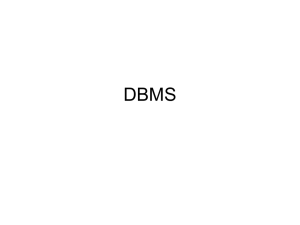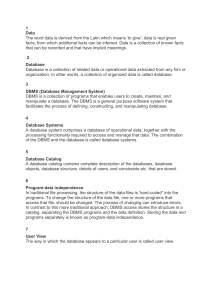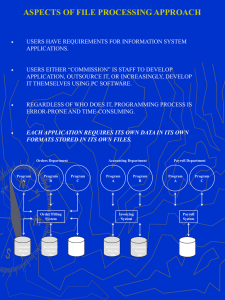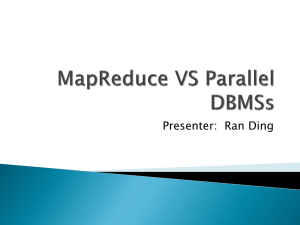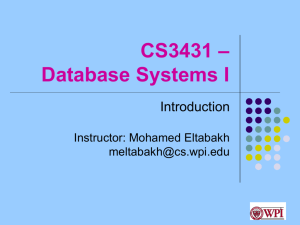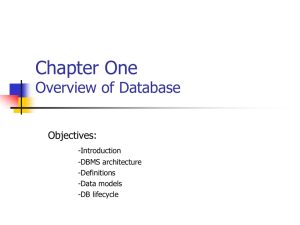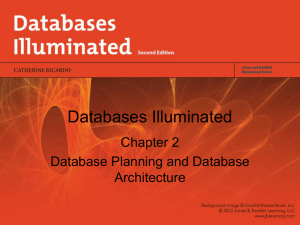Chapter 1
advertisement
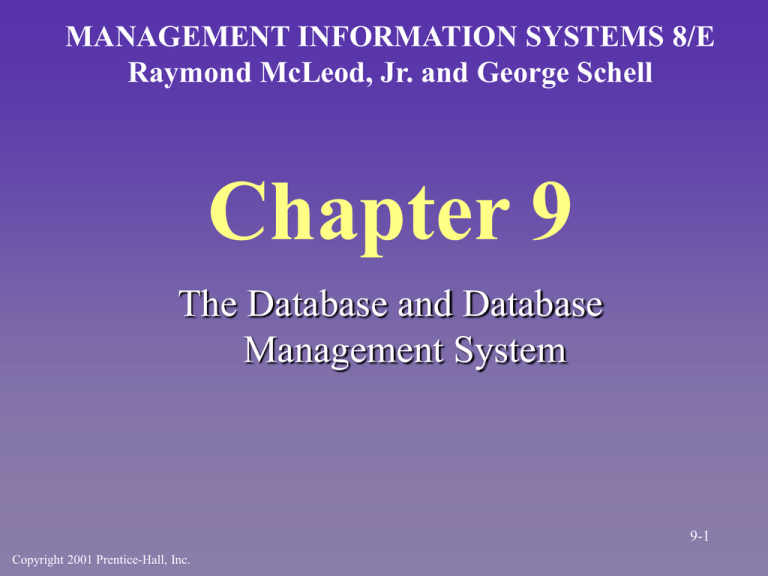
MANAGEMENT INFORMATION SYSTEMS 8/E Raymond McLeod, Jr. and George Schell Chapter 9 The Database and Database Management System 9-1 Copyright 2001 Prentice-Hall, Inc. Data Organization Data Field – Smallest unit of data Record – Collection of related fields File – Collection of related records 9-2 Data Organization (cont.) Folders – Collection of related files – Conceptually similar to a branch of the tree Subfolder – A folder within a folder Movement of folders using GUI 9-3 Organization of Data into Folders 9-4 Common Models for Organizing Data Files 1. Function 2. Frequency of Use 3. Users 4. Projects 9-5 Fundamental Building Blocks for Database Structures 1. Data Value 2. Data Field 3. Data Record 4. Data File 9-6 Spreadsheet as a Simple Database Rows and columns of a spreadsheet can be regarded as a simple database Flat files – Does not have repeating columns – Spreadsheet table is a file and column is a field Key fields – Contains a value to uniquely identify each record in a table 9-7 Data Structure vs. Spreadsheet Terminology Spreadsheet Term Table Column Row Data Structure Term File Field Record 9-8 Database Structures Database – All data stored on computer-based resources of the organization Database Management System (DBMS) – Software application that stores the structure of the database, the data itself, relationships among the data in the database, as well as forms and reports pertaining to the database 9-9 Database Structures (cont.) Hierarchical structure – – – – Uses the ‘parent / children’ concept Limitation: Cannot handle ad hoc requests First DBMS was IDS by GE in 1964 CODASYL Network structure – Allow given record to point back to any other record in the database – Specification released by CODASYL in 1971 – Solves problem of having to backtrack through 9-10 data Database Structures (cont.) Relational structure – Rows and columns – Frees designers from need to specify relationships prior to building the database – Date and Codd described structure – Does not rely on physical relationships – Easy to understand 9-11 Relational Database Vendors 1. IBM 2. Informix Software, Inc. 3. Microsoft 4. Oracle 5. Sybase 9-12 The Database Concept Database concept – Logical integration of records in multiple files Data redundancy – Duplication of data Data inconsistency Data independence – Keep data specifications separate from programs, in tables and indexes 9-13 Tables Book Name Banking Principles Management Information Systems 8E Personal Sales Techniques Quality Service, Quality Customer Author Knox McLeod and Schell Wei Brutus Required 25 75 70 54 9-14 Description of Book Table 9-15 Description of Student Table 9-16 Table Relationships 9-17 Salesperson file Buyer file Sales statistics file Customer file Inventory file Vendor file Purchase order file General ledger file Accounts receivable file Accounts payable file A Database Consists of One or More Files 9-18 Evolution of Database Software GE’s IDS first example – Used with COBOL IBM’s IMS – Apollo project Interface Issues – Intel’s System 2000, RAMIS, IDMS, Inquire – Query language interface 9-19 Evolution of Database Software (cont.) SEQEL from IBM – Continuation of IMS Renamed SQL – Structured Query language – Embedded within traditional language – Standalone PC database packages – dBase II – MS-Access 9-20 Creating a Database Two approaches: 1. Process oriented approach (problemsolving) 2. Enterprise modeling 9-21 1. Define the Problem 2. Identify necessary decisions 3. Describe information needs 4. Determine the necessary processing 5. Specify data needs 6. Data Specifications Data Needs Can Be Defined by Taking a ProblemOriented Approach 9-22 Strategic Planning for Information Resources 1. Create enterprise data model Enterprise Data Model 2. Develop Database Data Needs Can Be Defined by Creating an Enterprise Model Database 9-23 Describing the Database Contents Data dictionary Step 1 Enter dictionary data Step 2 Data description language (DDL) Schema 9-24 Schema Data field name Aliases (other names used for same data field) Type of data (numeric alphabetic) Number of positions Number of decimal positions Various integrity rules 9-25 Rule for Required Field 9-26 Enforcing Value of BookName 9-27 Creating a Database 1) Describe the data 2) Enter the data 3) Use the database – Query language – Query-by-example – Data manipulation language (DML) 9-28 Query-by-Example 9-29 On-Line Analytical Processing (OLAP) Feature to enable data analysis similar to statistical cross-tabulation Information can be generated from within DBMS No need for separate statistical software 9-30 Example OLAP Output Payment Method Marital Status Married Single Cash $752 $849 Credit $1,277 $2,019 Check $283 $165 9-31 The Database Administrator (DBA) D B A Duties Database planning; work with users and others, define schema, etc. Database implementation; creating the database and enforcing policies and procedures Database operations Database security 9-32 Data description language processor A DBMS Model Database description (schema) Database manager Query language Data manipulation language (DML) Database Performance statistics Application programs Performance statistics processor Transaction log Information Performance statistics Information requests Backup/recovery module 9-33 Knowledge Discovery in Databases (KDD) Data warehousing – refinement in the database concept to make it » very large » very pure » very retrievable Data mart – a more modest approach than data warehousing, generally only one segment of the firm 9-34 Knowledge Discovery in Databases (KDD) (cont.) Data mining – the process of finding relationships in data that are unknown to the user – may be for » verification » discovery » combination of verification and discovery 9-35 The Knowledge Discovery in Database (KDD) Process 1. Define the data and the task 2. Acquire the data 3. Clean the data 4. Develop the hypothesis and search model 5. Mine the data 6. Test and verify 7. Interpret and use 9-36 DBMS Advantages Reduce data redundancy Achieve data independence Enable integration of data from multiple files Retrieve data and information quickly Improve security 9-37 DBMS Disadvantages Requires a firm to: Obtain expensive software Obtain a large hardware configuration Hire and maintain a DBA staff 9-38 Summary Organizations are storing vast amounts of data Organization and structures in database – Dominated by relational Staff positions – DBA Knowledge discovery in databases Database management systems 9-39
